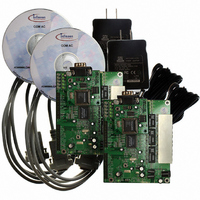EASY 6996M CPU Infineon Technologies, EASY 6996M CPU Datasheet - Page 71

EASY 6996M CPU
Manufacturer Part Number
EASY 6996M CPU
Description
BOARD EVAL W/CPU ADM6996M
Manufacturer
Infineon Technologies
Series
Samurair
Datasheet
1.EASY_6996M_CPU.pdf
(216 pages)
Specifications of EASY 6996M CPU
Main Purpose
Interface, Ethernet
Embedded
No
Utilized Ic / Part
ADM6996M
Lead Free Status / RoHS Status
Lead free / RoHS Compliant
Secondary Attributes
-
Primary Attributes
-
Other names
EASY6996MCPUIN
- Current page: 71 of 216
- Download datasheet (8Mb)
3.3.1
The Auto Negotiation function provides a mechanism for exchanging configuration information between two ends
of a link segment and automatically selecting the highest performance mode of operation supported by both
devices. Fast Link Pulse (FLP) Bursts provide the signaling used to communicate auto negotiation abilities
between two devices at each end of a link segment. For further details regarding auto negotiation, refer to Clause
28 of the IEEE 802.3u specification. The Samurai-6M/6MX (ADM6996M/MX) supports four different Ethernet
protocols, so the inclusion of auto negotiation ensures that the highest performance protocol will be selected
based on the ability of the link partner.
The auto negotiation function within the Samurai-6M/6MX (ADM6996M/MX) can be controlled either by internal
register access or by the use of configuration pins are sampled. If disabled, auto negotiation will not occur until
software enables bit 12 in MII register 0. If auto negotiation is enabled, the negotiation process will commence
immediately.
When auto negotiation is enabled, the Samurai-6M/6MX (ADM6996M/MX) transmits the abilities programmed into
the auto negotiation advertisement register at address 04h via FLP bursts. Any combination of 10 Mbit/s, 100
Mbit/s, half duplex, and full duplex modes may be selected. Auto negotiation controls the exchange of
configuration information. Upon successfully auto negotiation, the abilities reported by the link partner are stored
in the auto negotiation link partner ability register at address 05
The contents of the “auto negotiation link partner ability register” are used to automatically configure to the highest
performance protocol between the local and far-end nodes. Software can determine which mode has been
configured by auto negotiation by comparing the contents of register 04
technology whose bit is set in both registers of highest priority relative to the following list.
100Base-TX full duplex (highest priority)
100Base-TX half duplex
10Base-T full duplex
10Base-T half duplex (lowest priority)
The basic mode control register at address 0h provides control of enabling, disabling, and restarting of the auto
negotiation function. When auto negotiation is disabled, the speed selection bit (bit 13) controls switching between
10 Mbit/s or 100 Mbit/s operation, while the duplex mode bit (bit 8) controls switching between full duplex operation
and half duplex operation. The speed selection and duplex mode bits have no effect on the mode of operation
when the auto negotiation enable bit (bit 12) is set.
The basic mode status register at address 1h indicates the set of available abilities for technology types (bit 15 to
bit 11), auto negotiation ability (bit 3), and extended register capability (bit 0). These bits are hardwired to indicate
the full functionality of the Samurai-6M/6MX (ADM6996M/MX). The BMSR also provides status on:
Whether auto negotiation is complete (bit 5)
Whether the Link Partner is advertising that a remote fault has occurred (bit 4)
Whether a valid link has been established (bit 2)
The auto negotiation advertisement register at address 4h indicates the auto negotiation abilities to be advertised
by the Samurai-6M/6MX (ADM6996M/MX). All available abilities are transmitted by default, but writing to this
register or configuring external pins can suppress any ability.
The auto negotiation link partner ability register at address 05h indicates the abilities of the Link Partner as
indicated by auto negotiation communication. The contents of this register are considered valid when the auto
negotiation complete bit (bit 5, register address 1h) is set.
3.3.2
The twelve sets of four pins listed in
6M/6MX (ADM6996M/MX). The logic states of these pins are latched into the advertisement register (register
Data Sheet
Auto Negotiation
Speed/Duplex Configuration
Table 46
configure the speed/duplex capability of each channel of Samurai-
71
H
.
H
and 05
H
Revision 1.4, 2006-03-24
and then selecting the
Function Description
Samurai-6M/MX
ADM6996M/MX
Related parts for EASY 6996M CPU
Image
Part Number
Description
Manufacturer
Datasheet
Request
R

Part Number:
Description:
Easy-Up Pitch Pad Kit, Pitch Pad And Lag Bolt Kit. Pads Reduce Risk Of Water Leakage. Used When Mounting Antennas On Roof, Features: Contains 6 Lag Bolts, Quantity: Contains Six Lag Bolts
Manufacturer:
EASY-UP

Part Number:
Description:
PLC, CPU, DIGITAL
Manufacturer:
EASY
Datasheet:

Part Number:
Description:
Flex Cable Connector,PCB Mount,6 Contacts,Number Of Contact Rows:1,SURFACE MOUNT Terminal,LOCKING
Manufacturer:
Molex Inc
Datasheet:

Part Number:
Description:
PLC, CPU, DIGITAL/ANALOG
Manufacturer:
EASY
Datasheet:

Part Number:
Description:
EASY CONTROL, 24VDC, RELAY OUTPUT
Manufacturer:
MOELLER
Datasheet:

Part Number:
Description:
CONN FFC 15POS .50MM R/A ZIF SMD
Manufacturer:
Molex Inc
Datasheet:

Part Number:
Description:
CONN FFC 16POS .50MM R/A ZIF SMD
Manufacturer:
Molex Inc
Datasheet:

Part Number:
Description:
CONN FFC 18POS .50MM R/A ZIF SMD
Manufacturer:
Molex Inc
Datasheet:

Part Number:
Description:
CONN FFC 16POS .50MM R/A ZIF SMD
Manufacturer:
Molex Inc
Datasheet:

Part Number:
Description:
CONN FFC 19POS .50MM R/A ZIF SMD
Manufacturer:
Molex Inc
Datasheet:

Part Number:
Description:
CONN FFC 20POS .50MM R/A ZIF SMD
Manufacturer:
Molex Inc
Datasheet:

Part Number:
Description:
CONN FFC 22POS .50MM R/A ZIF SMD
Manufacturer:
Molex Inc
Datasheet:

Part Number:
Description:
CONN FFC 30POS .50MM R/A ZIF SMD
Manufacturer:
Molex Inc
Datasheet:

Part Number:
Description:
CONN FPC 10POS .5MM SMD R/A ZIF
Manufacturer:
Molex Inc
Datasheet:

Part Number:
Description:
CONN FPC 24POS .5MM SMD R/A ZIF
Manufacturer:
Molex Inc
Datasheet:










